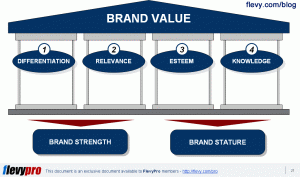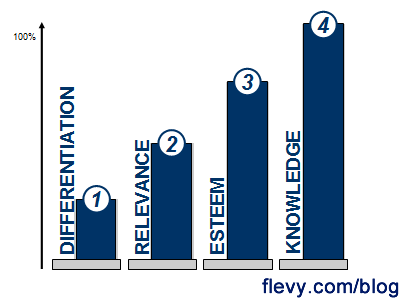Editor's Note: Take a look at our featured best practice, Strategic Branding (25-slide PowerPoint presentation). What is your brand important? Brands is a major driver of consumer behavior. A strong brand leads to higher market share and higher profit margins. It serves as a significant competitive advantage. In this presentation, we understand what "brand" is dig deeper into why it's important. [read more]
Brand Strategy 101. How Can You Make Your Brand Stronger?
* * * *
Based on research with almost 200,000 consumers across 40 countries, the ad agency Young & Rubicam developed a Brand Value framework called the Brand Asset Valuator (BAV). BAV is based on one of the most extensive research programs on branding ever conducted.

- Differentiation,
- Relevance,
- Esteem, and
- Knowledge.
As a brand forms and grows, it develops strengths across these 4 pillars, typically in the order listed above. This multi-stage process is known as the Brand Development Lifecycle (more on this later).
1. Differentiation
The starting point for all brands is differentiation. It defines the brand and distinguishes it from all others. Differentiation is how brands are born.
As a brand matures, differentiation often declines. However, even after reaching maturity, with good management, a brand can perpetuate its differentiation. A low level of differentiation is a clear warning that a brand is fading.
2. Relevance
Next, we move to relevance. If a brand isn’t relevant, or personally appropriate to consumers, it isn’t going to attract and keep them–at least not in any great numbers.
There is a distinct correlation between relevance and market penetration. In fact, relevance drives franchise size.
Differentiation and Relevance taken together say a lot about the brand’s growth potential–i.e. the Brand Strength, also known as Brand Vitality. These two pillars point to the brand’s future value, rather than just reflecting its past.
Relevant Differentiation—remaining both relevant and differentiated—is the central challenge of every brand.
3. Esteem
In the progression of building a brand, esteem follows differentiation and relevance. It’s the consumer’s response to a marketer’s brand-building activity.
Esteem is itself driven by two factors: perceptions of quality and popularity, and the proportions of these factors differ by country and culture. A brand needs to manage these consumer perceptions.
4. Knowledge
Lastly, we have knowledge. If a brand has established its relevant differentiation and consumers come to hold it in high esteem, brand knowledge is the outcome and represents the successful culmination of building a brand.
Knowledge means being aware of the brand and understanding what the brand or service stands for.
Knowledge is not a consequence of media weight alone. Spending money against a weak idea will not buy knowledge. Rather, knowledge has to be achieved.
Esteem and Knowledge determine the current power of a brand–i.e. Brand Stature, which is more of a “report card” on past performance. This a lagging indicator of brand health.
Brand Stature indicates brand status and scope, the consumers’ response to a brand—therefore, it reflects current brand performance and is a strong strategic indicator.
Now that we have defined all 4 pillars, let’s examine the combination of pillar strengths more closely. Evaluating this reveals a great deal about the brand’s current health and future strategic positioning.
Let’s say we have a brand with the following pillar strengths, as depicted in the diagram below.
Leading with strong differentiation, this brand is successfully entering the market place, is healthy, and has potential to grow. As it continues to build the relationship with the consumer, brand relevance grows, and both esteem and knowledge will follow.
This is a classic example of unrealized potential. Examples would include momentum brands and successful emerging brands.
Now, let’s look at the exact opposite composition.
In this case, the brand’s highest pillar is knowledge, indicating that the brand is well understood by consumers. However, lower esteem, (even lower) relevance, and (lowest) differentiation indicate that the basis for choice is fading.
This is an example of an eroding brand–one that is past its glory days. Examples would include commodity brands and former brand leaders.
Brand Development Lifecycle
Through examining various combinations of pillar strengths, we can begin formulating a logical sequence that brands progress through as they grow (eventually decline). These progression, known as the Brand Development Lifecycle, can be intuitively depicted on a 2×2 constructed by using Brand Strength and Brand Stature as the 2 axes.

Where does your brand stand?
How can you make your brand stronger?
What are your thoughts on this framework?
You can download an editable PowerPoint about the the Brand Asset Valuator (BAV) here on the Flevy documents marketplace.

Do You Want to Implement Business Best Practices?
You can download in-depth presentations on Brand Strategy and 100s of management topics from the FlevyPro Library. FlevyPro is trusted and utilized by 1000s of management consultants and corporate executives.
For even more best practices available on Flevy, have a look at our top 100 lists:
- Top 100 in Strategy & Transformation
- Top 100 in Digital Transformation
- Top 100 in Operational Excellence
- Top 100 in Organization & Change
- Top 100 Management Consulting Frameworks
These best practices are of the same as those leveraged by top-tier management consulting firms, like McKinsey, BCG, Bain, and Accenture. Improve the growth and efficiency of your organization by utilizing these best practice frameworks, templates, and tools. Most were developed by seasoned executives and consultants with over 20+ years of experience.
Readers of This Article Are Interested in These Resources

|
|
Excel workbook
|
|
Excel workbook
| |||
About David Tang
David Tang is an entrepreneur and management consultant. His current focus is Flevy, the marketplace for business best practices (e.g. frameworks & methodologies, presentation templates, financial models). Prior to Flevy, David worked as a management consultant for 8 years. His consulting experience spans corporate strategy, marketing, operations, change management, and IT; both domestic and international (EMEA + APAC). Industries served include Media & Entertainment, Telecommunications, Consumer Products/Retail, High-Tech, Life Sciences, and Business Services. You can connect with David here on LinkedIn.
Top 10 Recommended Documents on Brand Strategy
» View more resources Brand Strategy here.
» View the Top 100 Best Practices on Flevy.















